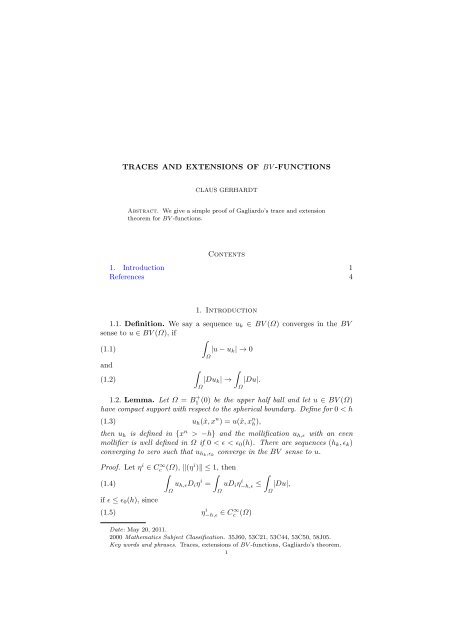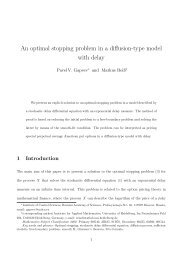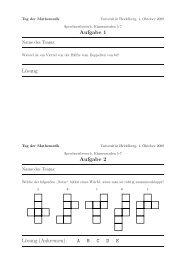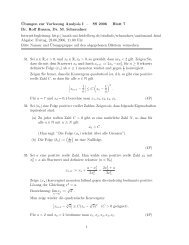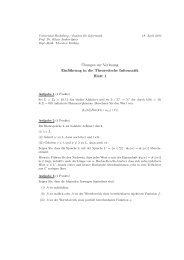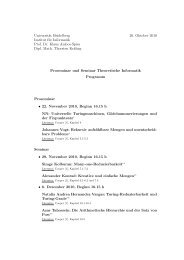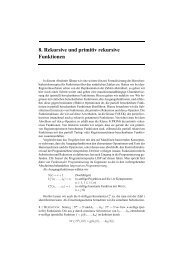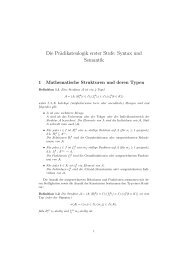Trace and extension theorems for BV-functions
Trace and extension theorems for BV-functions
Trace and extension theorems for BV-functions
You also want an ePaper? Increase the reach of your titles
YUMPU automatically turns print PDFs into web optimized ePapers that Google loves.
TRACES AND EXTENSIONS OF <strong>BV</strong> -FUNCTIONS<br />
CLAUS GERHARDT<br />
Abstract. We give a simple proof of Gagliardo’s trace <strong>and</strong> <strong>extension</strong><br />
theorem <strong>for</strong> <strong>BV</strong> -<strong>functions</strong>.<br />
Contents<br />
1. Introduction 1<br />
References 4<br />
1. Introduction<br />
1.1. Definition. We say a sequence u k ∈ <strong>BV</strong> (Ω) converges in the <strong>BV</strong><br />
sense to u ∈ <strong>BV</strong> (Ω), if<br />
∫<br />
(1.1)<br />
|u − u k | → 0<br />
<strong>and</strong><br />
(1.2)<br />
∫<br />
Ω<br />
Ω<br />
∫<br />
|Du k | →<br />
Ω<br />
|Du|.<br />
1.2. Lemma. Let Ω = B 1 + (0) be the upper half ball <strong>and</strong> let u ∈ <strong>BV</strong> (Ω)<br />
have compact support with respect to the spherical boundary. Define <strong>for</strong> 0 < h<br />
(1.3) u h (ˆx, x n ) = u(ˆx, x n h),<br />
then u h is defined in {x n > −h} <strong>and</strong> the mollification u h,ɛ with an even<br />
mollifier is well defined in Ω if 0 < ɛ < ɛ 0 (h). There are sequences (h k , ɛ k )<br />
converging to zero such that u hk ,ɛ k<br />
converge in the <strong>BV</strong> sense to u.<br />
Proof. Let η i ∈ Cc<br />
∞ (Ω), ‖(η i )‖ ≤ 1, then<br />
∫<br />
∫<br />
∫<br />
(1.4)<br />
u h,ɛ D i η i = uD i η−h,ɛ i ≤<br />
if ɛ ≤ ɛ 0 (h), since<br />
Ω<br />
(1.5) η i −h,ɛ ∈ C ∞ c (Ω)<br />
Ω<br />
Ω<br />
|Du|,<br />
Date: May 20, 2011.<br />
2000 Mathematics Subject Classification. 35J60, 53C21, 53C44, 53C50, 58J05.<br />
Key words <strong>and</strong> phrases. <strong>Trace</strong>s, <strong>extension</strong>s of <strong>BV</strong> -<strong>functions</strong>, Gagliardo’s theorem.<br />
1
2 CLAUS GERHARDT<br />
<strong>for</strong> those ɛ, where we may consider only η i the support of which is uni<strong>for</strong>mly<br />
compact with respect to the spherical boundary in view of the assumption<br />
on u. This proves the lemma.<br />
□<br />
1.3. Lemma. Let u, Ω be as above, then the approximating <strong>functions</strong><br />
u hk ,ɛ k<br />
, or any other sequence u k ∈ C 1 ( ¯Ω) converging in the <strong>BV</strong> sense to u,<br />
define a unique trace of u, tr u, on the hyperplane such that the divergence<br />
theorem holds<br />
∫<br />
∫ ∫<br />
(1.6)<br />
D i uη = − uD i η + uην i<br />
Ω<br />
Ω<br />
∂Ω<br />
<strong>for</strong> all η ∈ Cc 1 (Ω ɛ ∪ ∂Ω), cf. Remark 1.6.<br />
Extending u as an even function to the lower half space<br />
{<br />
(1.7) ũ(ˆx, x n u(ˆx, x n ) x n > 0,<br />
) =<br />
u(ˆx, −x n ) x n < 0,<br />
there holds<br />
(1.8)<br />
<strong>and</strong><br />
(1.9)<br />
∫<br />
B 1(0)<br />
∫<br />
∫<br />
|Dũ| ≤ 2 |Du|<br />
Ω<br />
∂Ω<br />
|Dũ| = 0.<br />
Proof. Let η i ∈ C 1 (B 1 (0)), then<br />
∫<br />
∫<br />
∫<br />
D i ũη i = D i uη i +<br />
(1.10)<br />
hence<br />
(1.11)<br />
B 1(0)<br />
B + 1<br />
∫<br />
= −<br />
B 1(0)<br />
∫<br />
Γ<br />
B − 1<br />
∫<br />
D i ũη i +<br />
Γ<br />
Γ<br />
D i ũη i<br />
∫<br />
∫<br />
ũD i η i + (u + − u + )η i ν i +<br />
D i ũη i = 0.<br />
Γ<br />
D i ũη i<br />
Moreover, if ‖(η i )‖ ≤ 1, we conclude from [2, Theorem 10.10.3] <strong>and</strong> (1.10)<br />
the estimate (1.8).<br />
□<br />
1.4. Theorem. Let Ω be as in the theorem below, then u ∈ <strong>BV</strong> (Ω) can<br />
be extended to R n with compact support such that, if the extended function is<br />
called ũ,<br />
∫ ∫<br />
(1.12)<br />
|Dũ| ≤ c (|Du| + |u|)<br />
R n Ω<br />
<strong>and</strong><br />
∫<br />
(1.13)<br />
|Dũ| = 0.<br />
∂Ω
TRACES AND EXTENSIONS OF <strong>BV</strong> -FUNCTIONS 3<br />
Proof. Let U k be a finite open covering of ¯Ω with the usual conditions <strong>for</strong><br />
the boundary neighbourhoods <strong>and</strong> let η k be a subordinate finite partition of<br />
unity, then each function uη k can be extended to R n with compact support<br />
such that, if ũ k is the extended function,<br />
∫<br />
∫<br />
(1.14)<br />
|Dũ k | ≤ c (|Du| + |u|).<br />
R n Ω<br />
The function<br />
(1.15) ũ = ∑ k<br />
ũ k<br />
is then an <strong>extension</strong> of u with the required properties.<br />
The above theorem is due to [1].<br />
□<br />
1.5. Theorem. Let u ∈ <strong>BV</strong> (Ω), where ∂Ω ∈ C 0,1 <strong>and</strong> compact, <strong>and</strong><br />
let u k ∈ C 1 ( ¯Ω) converging in the <strong>BV</strong> sense to u, at least in a boundary<br />
neighbourhood, then tr u k converges in L 1 (∂Ω) to a uniquely defined function<br />
depending only u <strong>and</strong> not on the approximating <strong>functions</strong>; we call this limit<br />
tr u. If u ∈ <strong>BV</strong> (Ω) ∩ C 0 ( ¯Ω), then<br />
(1.16) tr u = u |∂Ω<br />
Proof. It suffices to prove the uniqueness of the trace, since u can be extended<br />
to R n , <strong>and</strong> hence also be approximated by mollifications.<br />
Let u k <strong>and</strong> ũ k be C 1 ( ¯Ω) approximations of u <strong>and</strong> let v k = u k − ũ k , then<br />
∫<br />
(1.17) lim |v k | = 0,<br />
Ω ɛ<br />
where Ω ɛ is a boundary strip of width ɛ such that<br />
∫<br />
(1.18)<br />
|Du| = 0<br />
{d=ɛ}<br />
<strong>and</strong><br />
(1.19) lim sup<br />
∫<br />
|Dv k | ≤ 2<br />
Ω ɛ<br />
∫<br />
|Du|.<br />
Ω ɛ<br />
Now, there holds <strong>for</strong> any ɛ > 0<br />
∫<br />
∫<br />
(1.20)<br />
|v k | ≤ c |Dv k | + c ɛ |v k |,<br />
∂Ω<br />
∫Ω ɛ Ω ɛ<br />
hence<br />
∫<br />
∫<br />
(1.21) lim sup |v k | ≤ 2c lim sup<br />
∂Ω<br />
|Du| = 0,<br />
Ω ɛ<br />
where the last equality is due to the fact that |Du| is a bounded measure in<br />
Ω ɛ0 <strong>and</strong> the Ω ɛ are monotone ordered such that<br />
⋂<br />
(1.22)<br />
Ω ɛ = ∅.<br />
0
4 CLAUS GERHARDT<br />
□<br />
1.6. Remark. By approximation we also obtain<br />
∫<br />
∫ ∫<br />
(1.23)<br />
D i uη = − uD i η + uην i<br />
Ω<br />
<strong>for</strong> all η ∈ C 1 c (Ω ɛ ∪ ∂Ω).<br />
Ω<br />
1.7. Remark. The definition of <strong>BV</strong> (Ω), when Ω ⊂ N, where N is a<br />
Riemannian manifold is analogous to the case N = R n , namely,<br />
∫<br />
∫<br />
(1.24)<br />
|Du| = sup{ uD i η i : g ij η i η j ≤ 1, η i ∈ Cc ∞ (Ω) }.<br />
Ω<br />
Ω<br />
Even in the Euclidean case it is sometimes desirable to use the invariant<br />
definition of the total variation.<br />
References<br />
[1] Emilio Gagliardo, Caratterizzazioni delle tracce sulla frontiera relative ad alcune classi<br />
di funzioni in n variabili, Rend. Sem. Mat. Univ. Padova 27 (1957), 284–305.<br />
[2] Claus Gerhardt, Analysis II, International Series in Analysis, International Press,<br />
Somerville, MA, 2006.<br />
Ruprecht-Karls-Universität, Institut für Angew<strong>and</strong>te Mathematik, Im Neuenheimer<br />
Feld 294, 69120 Heidelberg, Germany<br />
E-mail address: gerhardt@math.uni-heidelberg.de<br />
URL: http://web.me.com/gerhardt/<br />
∂Ω


